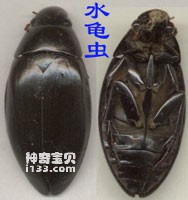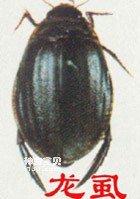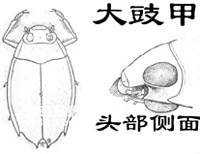1. Water turtles
The terrapin looks like a dragon louse and lives in the same water ecological environment as the dragon louse. Its body is streamlined and its dorsal and ventral surfaces are arched. However, its back is more protruding than that of the dragon louse, and its body color is darker than that of the dragon louse (almost black). ), the ventral surface is relatively flat, and in most species there is a thick and straight needle on the ventral surface of the thorax, which sticks to the ventral surface of the chest and extends backward (there is no needle in the dragon louse). The lower jaw must be long, as long as the antennae or longer. They can be distinguished from these points. This hard-shelled insect is good at crawling on objects in the water. When it swims to the surface, it often spins on the surface.

Terrapins belong to the order Coleoptera, the family Terrapinidae, also known as the family Odontidae, and there are about 2,000 species known in the world. The terrapin's antennae have 6-9 sections, and the end sections 3-4 are slightly enlarged. There is a shallow groove on one side of the antennae, which is covered by water-repellent hairs, thus forming a pipe. When breathing, it swims to the water surface and exposes its head. Air enters through the ducts in the tentacles and is stored in short hairs densely packed on the ventral surface that cannot be wetted by water. At this time, a large air layer can form on the hair, and the ventral surface turns silvery white due to dense blisters. The water turtles use the movement of the elytra and abdominal plates to suck the air in the bubbles into the air storage cavity and trachea under the elytra. Its ventilation in the water is also carried out by its tentacles. Adults of terrapins are generally herbivorous, while larvae are detritivorous or carnivorous, preying on animals such as tadpoles and small fish. Some species have been recorded as damaging rice.
2. Dragon louse
(1) Identification characteristics: The dragonfly belongs to the order Coleoptera and the family Dragonfly. Small to large, long eggs are streamlined, flat and smooth. The dorsal and ventral surfaces of the body are arched, the antennae are filamentous, with 11 segments, and the lower jaw is short. The head is retracted into the chest. The hindfoot is a swimming foot, and the posterior base section and posterior thorax and abdomen occupy more than half of the ventral surface. There was no acupuncture on the ventral surface of the chest.

There are about 4,000 known species in the world, and about 200 species have been recorded in my country. Common ones include Cybister japonicus Sharp, etc.
(2) Biological learning is completely abnormal. Both adults and larvae live in still or running water, and a few are found in brine or hot springs. They can prey on molluscs, insects, tadpoles or small fish. The larvae are particularly voracious. Adult worms are phototaxis, and their gluteal glands can release benzene benzoate and steroid substances that are significantly toxic to fish and other aquatic vertebrates, and can harm rice seedlings and wheat seedlings.
The dragon louse swims very fast, and its streamlined body resembles a fast submarine. The two pairs of long and flat middle and hind feet are covered with neatly arranged long hairs, just like a small four-oared cruise ship. The dragon louse has a small and flexible body, making it easier to chase fish. It uses its piercing and sucking mouthparts to suck the blood from the fish body. No matter how the fish swings, it will stick to the fish body and will not fall off. Sometimes several dragon lice chase a fish at the same time, and finally subdue the fish to death; they then get a delicious meal. In addition to preying on fish, dragon lice also prey on other small animals in the water and are pests in the fish farming industry.
How does the dragon louse reproduce and give birth to offspring? When it reaches sexual maturity and development, the male dragon louse chases the female dragon louse and uses the enlarged round suckers (clutching feet) at the base of the tarsus of its front feet to absorb the smooth front part of the female dragon louse's elytra Both sides, and crawl to the back of the female dragon louse to mate. From this point of view, the dragon louse is still dimorphic (female dragon louse has no suckers on its front legs). Female dragon lice lay fertilized eggs on aquatic plants, and the temperature of the water hatches into small larvae. The small larvae do not have an air sac and only rely on the trachea in the body to store very little air. Therefore, the incubation time in the water cannot be too long. They must often swim to the surface and expose the trachea at the end of the abdomen to the water to discharge waste gas and inhale fresh air. The larvae of the dragon louse feed on small fish, tadpoles and other animals, but it has no obvious mouth, and its upper jaw does not have the function of chewing food. Its upper jaw is hollow, with a small hole at the base that secretes digestive substances and connects the mouth and esophagus, and a small hole near the tip that absorbs liquid food. When it catches prey, it first spits out poisonous liquid from its esophagus, injects it into the prey through the hollow palate, and anesthetizes it. At the same time, it spits out liquid with strong digestive function to dilute the prey's substances, and then sucks the digested substances. Therefore, the feeding and digestion method of dragon louse larvae is called parenteral digestion.
If you are interested, you can collect some live dragon lice and water turtle bugs from ponds, rivers or rice fields with water nets or bottom nets in spring and summer, raise them in fish tanks, and collect some tadpoles or small fish for them to feed on. Observe the living habits, predatory behavior, breathing and ventilation of dragon lice and terrapins. This will not only develop your observation skills, but also enhance your interest in biology and entomology. However, during the breeding process, you should pay attention to changing the water and adding some aquatic plants for them to attach and inhabit.
(3) Superb diving skills. Human underwater operations or deep-sea investigations are generally completed by divers. Divers need to carry oxygen and a set of equipment to maintain underwater work for a relatively long time. There are also many divers among insects, and dragon lice are one of the outstanding ones. They can dive deep into the bottom of ponds for a long time. Even in winter, it can lurk at the bottom of the water under thick ice for a long time without suffocating due to lack of oxygen. After the cold winter, when the ice melts, it ends its life of hiding underwater and begins to swim freely in the water. Its ancestors originally lived on land, but later evolved into aquatic life due to changes in the earth's crust, so it still retains the characteristics of its ancestors breathing air. There is an air storage bag under the elytra of the dragon louse. This air storage bag has the function of "physical gills". It also plays a positioning role when the dragon louse swims up and down in the water. When the dragon louse stops on the water, its forewings gently shake to expel the carbon dioxide-containing waste gas from the body, and then uses the contraction pressure of the air sac to absorb fresh air from the air. The oxygen content in the air is many times greater than that in water, so aquatic insects have learned various ways to absorb air during their long-term evolution. The dragon louse relies on stored fresh air and lives in the water. When the oxygen in the air bag is used up, swim out of the water again, exhaust the exhaust gas again, and inhale fresh air.

3. Black bean paste
The beetles belong to the order Coleoptera, the suborder Carnivora, and the family Beetidae. The body length is usually only 6-7.5 mm, with the smallest being 4 mm and the largest being 17 mm. They are small insects. There are more than 900 known species in the world, and 44 species have been recorded in my country. The back is black and slightly shiny. Each compound eye is divided into upper and lower parts, as if there are two pairs of compound eyes. Because of its small body, like half a soybean, it is commonly known as "black bean insect". When out on a trip, on a calm pond surface, you can sometimes see black beetles swimming in circles during the day; it seems like something is drawing circles on the water, which is very eye-catching.
Black beetles are also insects that live on the surface of fresh water, but they are mostly found on calm, stagnant water such as ponds and small puddles. Adult beetles are nocturnal and often gather in the water at night to swim. Their swimming method is gyration swimming (rotation), which we call "spin swimming". As long as it does not leave the water, it will always spin. Why can the tympanum only swim on the surface of the water? Because its front legs are longer, but not paddle-shaped swimming legs with long hairs. The middle and hind legs are short and flat, with pincer-like ends, and can only perform tiny movements on the ventral surface of the body. The stirring motion of the water causes the water to form a vortex and drive the insect body to rotate. Because it is small in size, light in weight, and has a waxy skin, it will not be soaked by water. At the same time, it can also produce a water-resistant secretion to increase the surface tension of water, so the surface of water can carry soybean. A's body prevents it from sinking. Both adults and larvae of black beetles are predatory; they undergo complete metamorphosis.
animal tags:
We created this article in conjunction with AI technology, then made sure it was fact-checked and edited by a Animals Top editor.